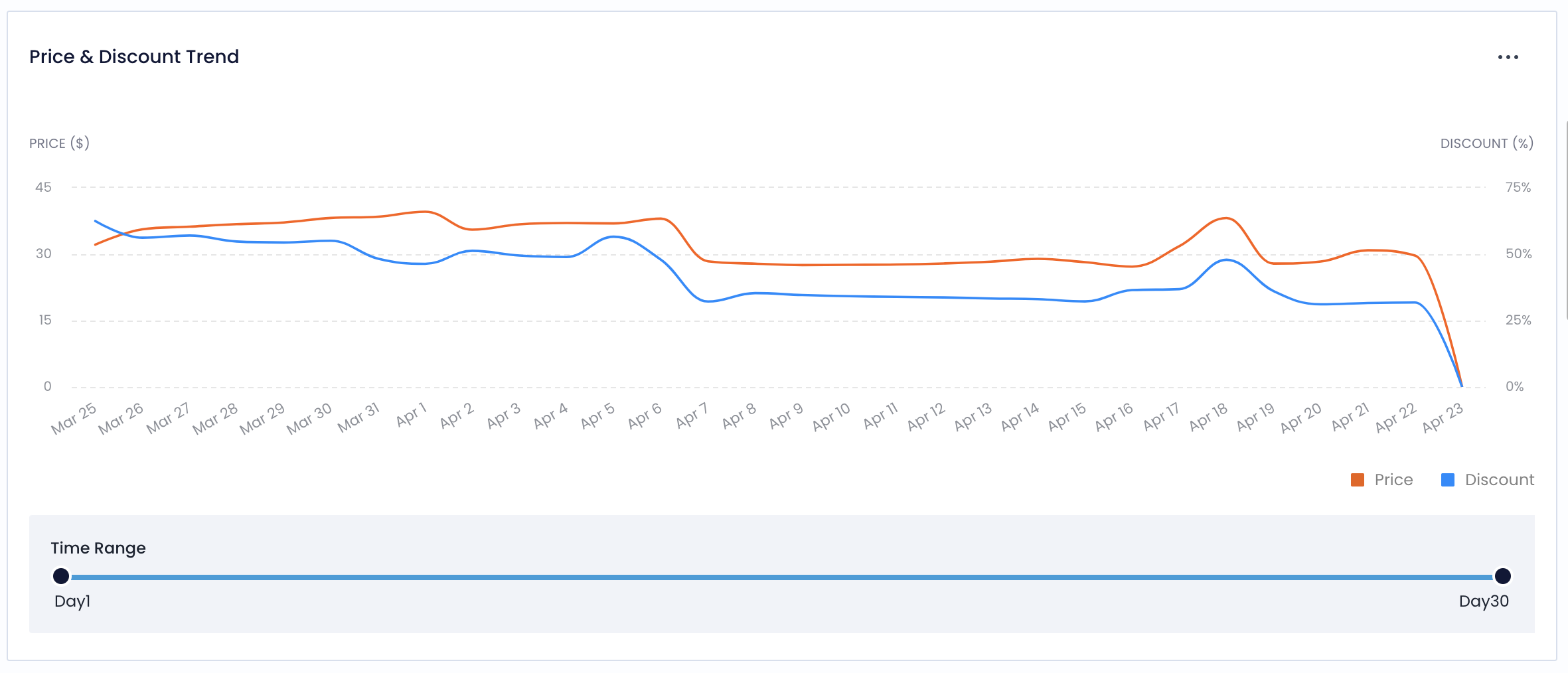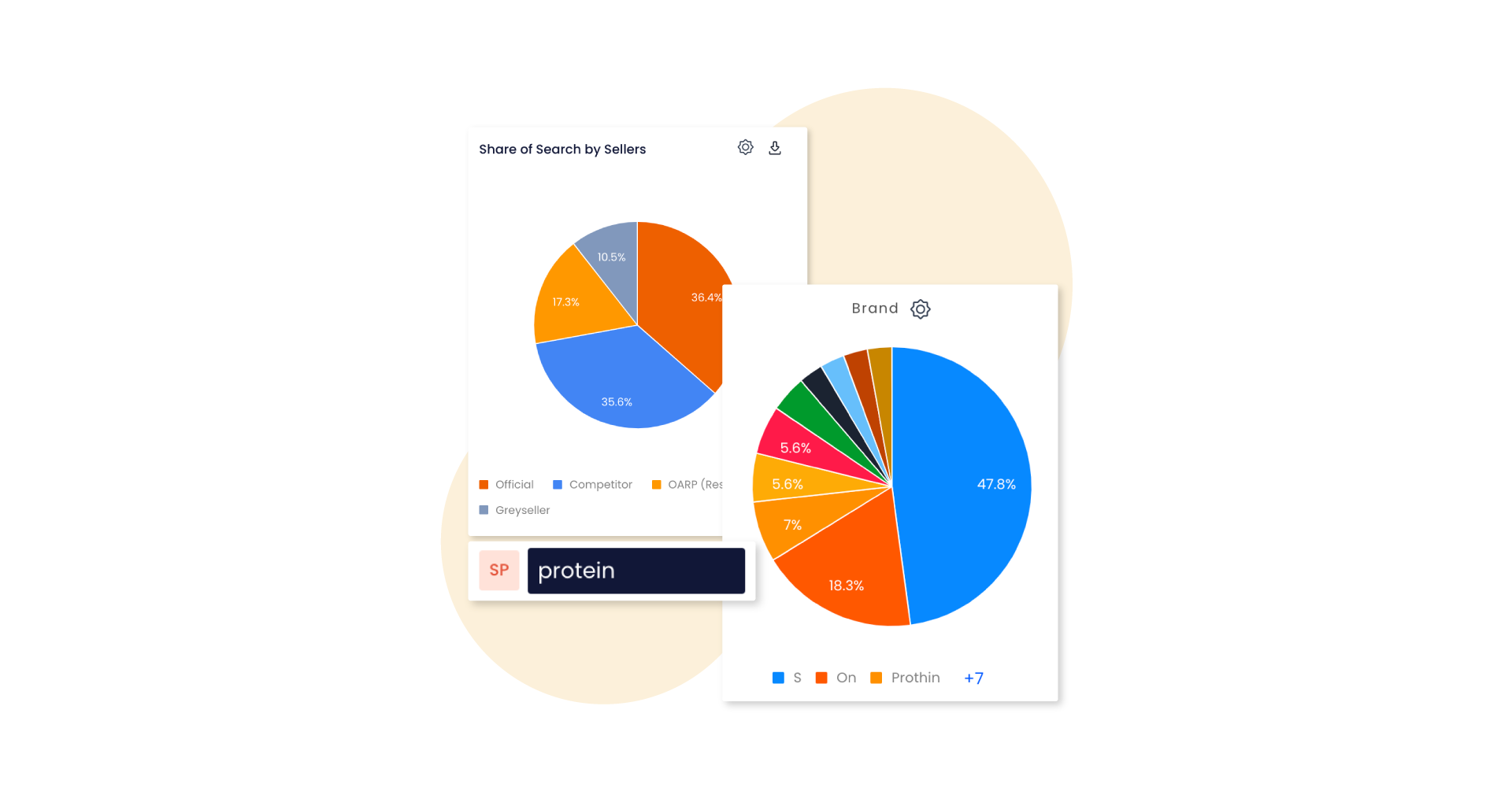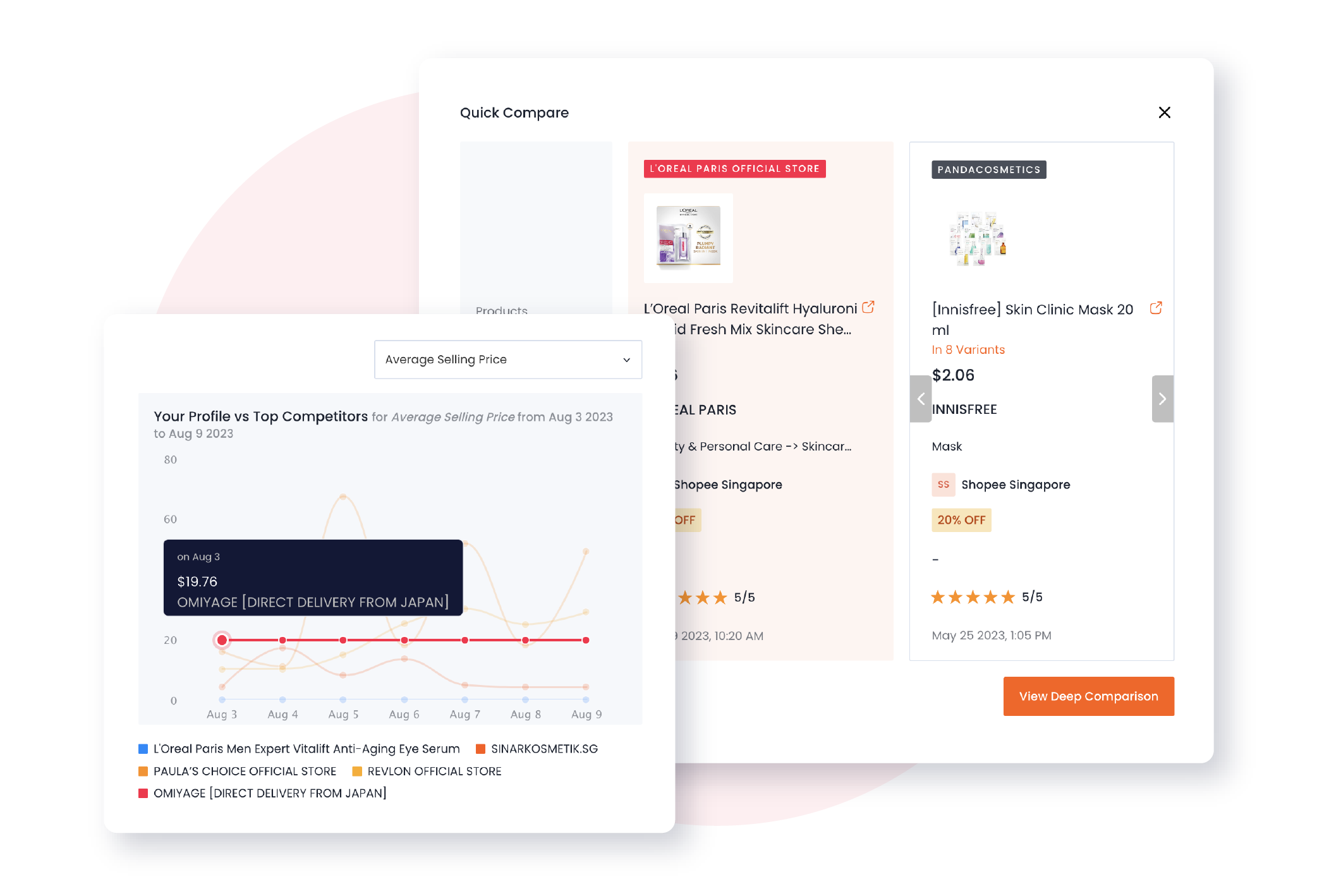Why is Digital Shelf Analytics Essential in Addition to E-commerce Tracking by GA4 Analytics
BlogsAre you struggling to understand the performance of your products across your brand’s digital shelf?
Given there’s high competition across the different sales channels you use, it can be difficult to determine your actual performance in real time. In this article, we will dive deep into the world of digital shelf analytics and compare it with e-commerce tracking in GA4 to help you unlock the performance information you’re looking for.
Digital shelf analytics provides valuable insights into how your products are performing on various online platforms including your web stores (yourbrand.com). By tracking key metrics such as product visibility, search rankings, and customer reviews, you can better understand your product’s performance and make data-driven decisions to optimize your online presence.
E-commerce tracking in GA4, on the other hand, is a powerful tool offered by Google Analytics that helps you analyze online sales and revenue. However, GA4 may not provide you with granular insights on business performance specific to digital shelf analytics.
Comparing the two approaches can help you determine how you can utilize each solution to meet your needs and goals. So, buckle up and get ready to uncover the secrets of digital shelf analytics, through the following sections:
- Understanding E-commerce Tracking in GA4
- Understanding Digital Shelf Analytics
- Key Differences Between Digital Shelf Analytics and E-commerce Tracking in GA4
- Implementing Digital Shelf Analytics in Your Marketing Strategy
- Best Practices for Leveraging Digital Shelf Analytics Effectively
- What Digital Shelf Analytics Helps You Achieve
- Conclusion and Key Takeaways
Understanding E-commerce Tracking in GA4
E-commerce tracking in GA4 is a tool offered by Google Analytics that allows businesses to analyze online sales and revenue [1]. By implementing the GA4 tracking code on your website (web store), you can gain insights into various e-commerce metrics such as transaction revenue, conversion rate, average order value, and more. This information is crucial for understanding the overall performance of your online store and making smart decisions to improve sales and customer experience.
However, while it provides valuable insights into your website’s e-commerce performance, GA4 may not provide you with detailed insights such as share of search, customer sentiment, content score, and inventory availability like digital shelf analytics.
Digital shelf analytics goes beyond measuring online sales and revenue and focuses on understanding how your products are performing across different online platforms.
Understanding Digital Shelf Analytics
Consumers have access to multiple online platforms to browse and purchase products. Therefore, your business must have a strong presence on the platforms you use. Digital shelf analytics helps you gain visibility into how your products are performing on various platforms, including e-commerce marketplaces and web stores. By tracking key metrics such as product visibility, search rankings, customer reviews, and competitor performance, you can make informed decisions to optimize your online presence and drive sales.
Digital shelf analytics allows you to monitor your product’s position in search results, identify gaps and opportunities, and optimize your product listings to improve visibility and conversion rates. It helps you understand which platforms drive the most traffic and sales, allowing you to allocate your resources effectively. Additionally, by monitoring customer reviews and feedback, you can identify areas for improvement and enhance your product offerings to meet customer expectations.
Key Differences Between Digital Shelf Analytics and E-commerce Tracking in GA4
While both digital shelf analytics and e-commerce tracking in GA4 provide valuable insights for businesses, there are key differences between the two approaches. E-commerce tracking in GA4 primarily focuses on tracking online sales and revenue on your website [2], while digital shelf analytics provides insights into how your products are performing across multiple online sales platforms.
But, focusing on tracking online sales and revenue is not enough to sustain e-commerce growth.
To boost your e-commerce performance, you need digital shelf analytics such as Anchanto’s SaaS platform to monitor your product’s visibility, search rankings, and customer reviews on various digital shelves. It provides you with a holistic view of your product’s performance, including how it compares to competitors and how it resonates with consumers on different platforms.
Implementing Digital Shelf Analytics in Your Marketing Strategy
Now that you understand the benefits of digital shelf analytics, let’s explore how you can implement it in your marketing strategy. Here are some steps to get started:

- Define your goals: Clearly define your goals and objectives for implementing digital shelf analytics. Are you looking to increase product visibility, improve search rankings, or enhance customer reviews? A clear sense of your goals will help determine if this solution is ideal for your success.
- Choose the right tools and platforms: There are various tools and platforms available for digital shelf analytics like Anchanto’s Digital Shelf technology. Research and choose a solution with capabilities that align with your business needs and goals.
- Set up tracking and monitoring: Implement the necessary integrations to start collecting data. This will involve integrating your web stores with the chosen digital shelf analytics platform and setting up API connections. Ensure that you have access to accurate and real-time data for effective analysis.
- Analyze and interpret the data: Once you have collected data, analyze it to gain insights into your product’s performance. Look for trends, patterns, and correlations that can help you make informed decisions. Pay attention to key metrics such as share of search, customer sentiment scores, competitor performance, etc.
- Optimize your marketing efforts: Use the insights gained from digital shelf analytics to optimize your marketing efforts. Adjust your product titles, descriptions, and images to improve visibility and conversion rates. Develop strategies to address competitor strengths and weaknesses. Also, leverage platform-specific trends to maximize your business presence and sales results.
- Monitor and iterate: Digital shelf analytics is an ongoing process. Continuously monitor your product’s performance, track changes in metrics, and iterate your strategies accordingly. Regularly review and update your product listings, monitor customer reviews, and stay updated with platform-specific trends to stay ahead in the market.
Best Practices for Leveraging Digital Shelf Analytics Effectively
To make the most out of digital shelf analytics, consider the following best practices:
- Track relevant metrics: Choose metrics that align with your goals and objectives. Focus on metrics such as market share, pricing, share of search, promotion performance, content quality scores, inventory availability, and brand protection. Tracking irrelevant or vanity metrics can lead to analysis paralysis and distract you from actionable insights.
- Monitor customer reviews: Customer reviews provide valuable feedback and insights into your product’s performance. Regularly monitor customer reviews, address concerns, and use feedback to improve your product offerings. Encourage satisfied customers to leave positive reviews to enhance your product’s reputation.
- Leverage platform-specific trends: Different platforms have unique characteristics and audiences. Stay updated with platform-specific trends and consumer behavior to tailor your marketing efforts and product offerings. For example, if you notice product bundles perform better on Lazada, focus on creating more and examine the results.
- Consider market dynamics: The digital landscape is constantly evolving, and market dynamics can change rapidly. Keep an eye on industry trends, competitor strategies, and consumer preferences to adapt your business strategies accordingly. Stay agile and be willing to pivot your approach when necessary.
- Connect with other data sources: Digital shelf analytics is just one piece of the puzzle. Combining it with other data sources, such as website analytics, social media analytics, and customer relationship management (CRM) data, will give you a holistic view of your business performance. Identify correlations and patterns across different data sources for more comprehensive insights.
Implement Best Practices with Our Experts
What Digital Shelf Analytics Helps You Achieve
So far, we’ve explained that digital shelf analytics delves into your online performance while analyzing competitor data. It offers comprehensive insights to boost your business, but to what extent?
1. Market share analysis
Market share analysis through digital shelf analytics enables you to assess your market position and performance. By checking the percentage of market sales attributed to your brand compared to competitors, you can gauge your overall brand market share. Evaluating your market share within specific product categories helps you understand category-specific performance. You can also determine how individual products are performing relative to competitors for a granular view of product market share. Measuring market share through units sold or Gross Merchandise Value (GMV) also provides a clear picture of your brand’s competitive standing.
2. Pricing optimization
Digital shelf analytics can help you conduct competitive pricing analysis so you can monitor and compare prices with competitors across various platforms. This will allow you to understand the current market pricing dynamics. Based on this data, you can make price adjustments to stay competitive. Implementing optimized pricing strategies further optimizes sales and profitability by adjusting prices in real time based on demand and competitor actions.
3. Promotion effectiveness
You can check your promotion effectiveness through digital shelf analytics by comparing your promotion strategies, such as discounts and BOGO (buy-one-get-one free) offers, with those of competitors. Performing sales impact analysis will help in understanding how different promotional tactics affect sales volume. Additionally, experimenting with promotions used by competitors can reveal new strategies to boost your sales.
4. Content quality improvement
To attract and convert shoppers, you must continuously enhance your content quality. By measuring the quality of your product listings based on specific criteria, you can ensure that your listings are up to standard. Identifying and incorporating relevant keywords helps improve product descriptions and titles, making them more searchable. Enhancing product descriptions and images also attracts more shoppers and increases conversion rates.
5. Share of search enhancement
Knowing your share of search is a critical metric for online visibility. Monitoring your brand’s visibility in search results for relevant keywords and categories helps in assessing search performance. SEO optimization of product listings ensures better search engine rankings. Additionally, comparing your search ranking with that of competitors identifies areas for improvement, helping you to stay ahead in search results.

6. Inventory availability management
To ensure you’re meeting customer demand, you must have inventory available. By monitoring inventory levels and forecasting demand for all product variants, you can avoid stockouts and overstock situations. Making sure popular products are always in stock helps in maintaining sales momentum. And keeping an eye on new product launches and stock levels of competitors provides a competitive edge.
7. Brand protection
It is essential to maintain brand integrity and reputation by taking steps to protect it. Monitoring authorized and unauthorized sellers of your products helps in controlling your distribution channels. Detecting price violations, such as undercutting or violating Minimum Advertised Price (MAP) policies, ensures fair pricing practices. Similarly, making sure that sellers use accurate and authorized product descriptions and images maintains brand consistency.
8. Competitor performance insights
Gaining insights into competitor pricing strategies helps in understanding their pricing models. That way, you know what keywords competitors are targeting for better search results. Analyzing how competitors are positioning themselves in the market identifies gaps and opportunities, helping you to refine your market strategies.

9. Platform-specific opportunities
Different digital shelves have unique characteristics and audiences. Digital shelf analytics helps you determine which platforms drive the most traffic and sales for your products. By understanding platform-specific trends and consumer behavior, you can tailor your marketing efforts and product offerings to maximize your sales results.
10. Improve customer experience
Customer reviews and feedback play a crucial role in shaping your product’s reputation and customer perception. Digital shelf analytics allows you to monitor customer sentiment and identify areas for improvement. By addressing customer concerns and enhancing your product offerings, you can improve the overall customer experience and loyalty.
Share Your Requirements with Our Experts!
Conclusion and Key Takeaways
In conclusion, digital shelf analytics is a powerful tool that provides you with valuable insights into how your products are performing across various online platforms. While e-commerce tracking in GA4 focuses on tracking online sales and revenue on your website or web store, digital shelf analytics goes beyond that and helps you understand your product’s performance and visibility on different digital shelves.
so, unlock the power of digital shelf analytics, embrace the power of data-driven decisions, and watch your business thrive in the digital landscape.
Key takeaways:
- E-commerce tracking in GA4 focuses on tracking online sales and revenue on your website, while digital shelf analytics provides insights into your product’s performance across various online platforms.
- Implementing digital shelf analytics involves defining goals, choosing the right tools, setting up tracking, analyzing data, optimizing efforts, and continuously monitoring and iterating for improvements.
- Best practices for leveraging digital shelf analytics effectively include tracking relevant metrics, monitoring customer reviews, leveraging platform-specific trends, considering market dynamics, and integrating with other data sources.
Take your online presence to new heights!
FAQs
1. What is digital shelf analytics?
Digital Shelf Analytics is a software that involves analyzing e-commerce data to gain a comprehensive view of your online presence, enabling you to optimize your e-commerce strategies. It examines aspects such as market share, pricing, customer sentiment, and competitor positioning on e-commerce platforms, helping you identify hidden opportunities and potential gaps in your online offerings.
2. What is e-commerce tracking?
E-commerce tracking is a feature provided by Google Analytics 4. It monitors users’ shopping activities on your website. By default, it tracks website metrics like pageviews, traffic sources, session duration, and bounce rates to provide detailed insights into online shopping behavior.
3. What is the best mix to monitor your digital shelf?
To effectively monitor your digital shelf, use a combination of Google Analytics 4 (GA4) and Digital Shelf Analytics. GA4 helps you measure website traffic and conversion rates, while Digital Shelf Analytics evaluates your market share, growth, and overall e-commerce performance. This mix provides a comprehensive view of both user behavior and competitive positioning, ensuring a holistic approach to optimizing your online presence.
References –
